If the crankcase in your car's engine leaked, you’d probably do something about it. Same goes for parts in your shower.
But have you paid attention to what might be leaking off your property when it rains? In the dark ages of subdivision design, rain that fell on roofs, patios and oil-stained driveways was treated as the enemy. “Stick it in a pipe and get that stuff off the property,” was what I learned when I was studying landscape architecture.
“What’s the fuss?” you might ask. “Water is
supposed to find its way to the ocean and rivers; that’s what nature does.” True, but nature didn’t intend for it to carry all the nasty stuff we’ve allowed to pollute it, like motor oil, dust from brake linings and tires, lawn chemicals and the like. And nature didn’t know we’d be paving nearly every square inch of the civilized world. Or building over the wetlands and lagoons that used to slow, filter and detain much of that runoff.
Fortunately, for the sake of our rivers, streams and shorelines, the age of enlightenment now shines upon the discipline of stormwater management. Words like "bioswale," "detention basin" and "permeable paving"
are commonplace in the design world.
The benefits of handling stormwater intelligently? More water stays on your property, reducing your irrigation bill. In low-rainfall areas, allowing rainwater to seep into your garden helps leach out salts that accumulate in the soil from mineral in the municipal water supplies. And then there’s the good you’ll be doing for the environment by not overtaxing storm drains, by reducing the algae buildup that results from nutrient-laden runoff and by releasing cleaner water into natural waterways.
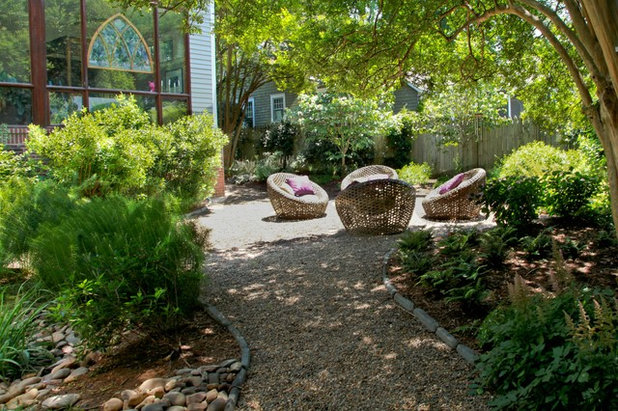
groundworks studio
One of the key concepts for capturing and keeping the water that falls in your yard is permeability. Gravel walkways and soil that's cultivated and mulched (instead of raked into submission and with all organic material removed) create the ideal surface to absorb water.
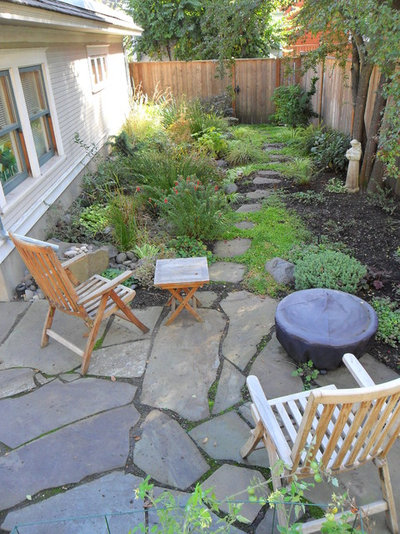
Plan-it Earth Design
This design makes the most of a narrow yard by including an intimate chill-out space, an alluring display of low plants and open space where water can flow and infiltrate the soil. Unlike concrete or mortared brick, which shed water, flagstone laid with generous gaps like this gives rainwater a chance to move directly into the ground.
More about permeable paving
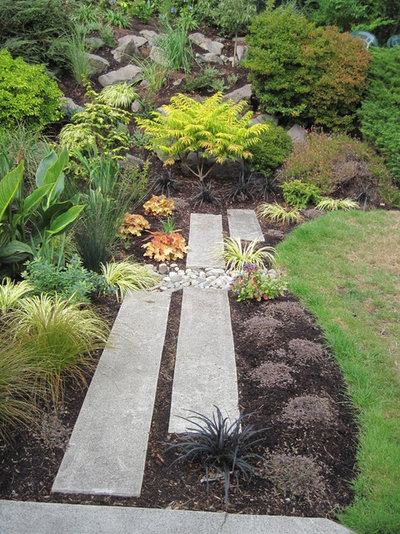
Banyon Tree Design Studio
Mini rain gardens can be situated at the low side of a yard to filter excess runoff from the lawn. Even if you've gone organic in your lawn care regimen, there's still the problem of nutrients (nitrogen, phosphorus, potassium and other elements) entering waterways. They don't just make your lawn grow; they can accelerate algae growth, which in turn upsets the habitat of fish and other aquatic life.
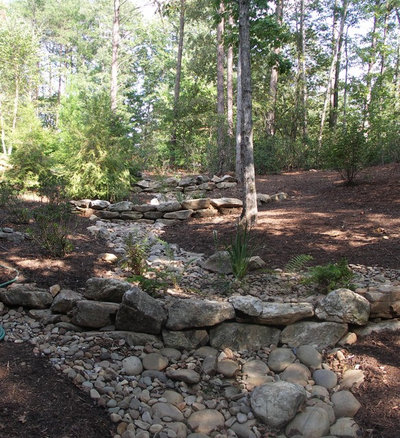
Earth Design, Inc.
Depending on your garden's surroundings, something as simple as a dry creek bed might be all that's needed to slow the flow of water, reduce the chances of erosion and give the water time to seep into the soil. In a setting like this forest, a simple palette of native plants that don't mind having their toes wet (think ferns, sedges and reeds) will appear right at home.
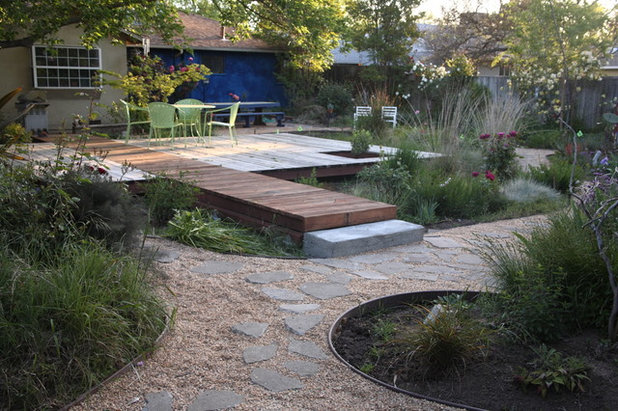
Luciole Design Inc.
I don't know about you, but when I see a bridge, I think water. This understated design element not only creates visual flow toward the generous deck, but the moat-like bed does double duty: It's a beautiful planting composition and a pocket where excess water can harmlessly stay on the property.
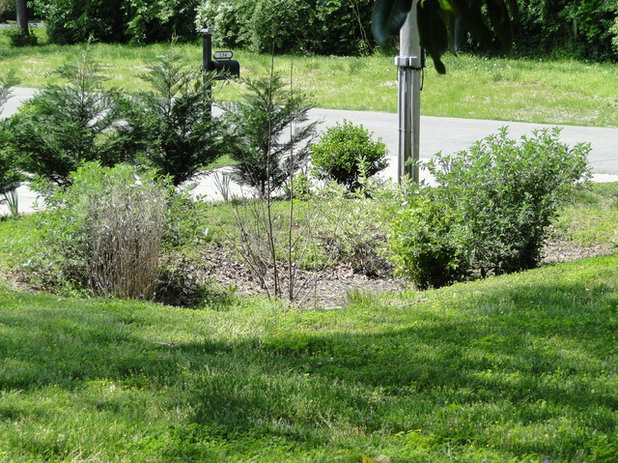
Sullivan Design & Construction, LLC
Every little bit counts. Even a little divot like this is a good thing. If space allows, these can be strung throughout your yard as what some stormwater experts call a detention train. Be sure to select plants that don't mind having their toesies wet during the rainy season. Ideally, these will be native plants that occur in boggy areas in nature. Check with your local native plant society.
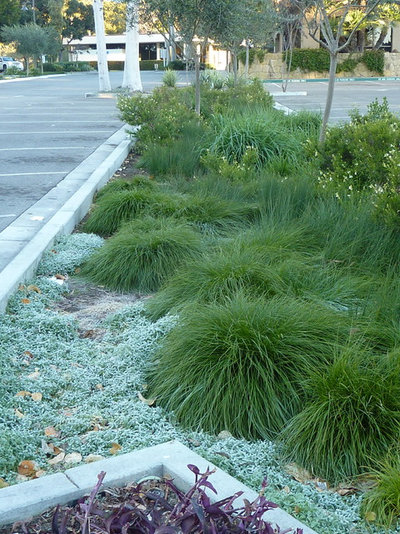
Billy Goodnick Garden Design
Although the size of this Whole Foods parking lot in Santa Barbara, California, is out of scale for most homes, it illustrates a sound principle for those undertaking new construction. If you create a cross pitch that sends water to a planted island through cuts in the curb, all that nasty stuff that accumulates on your new driveway can be scrubbed clean.
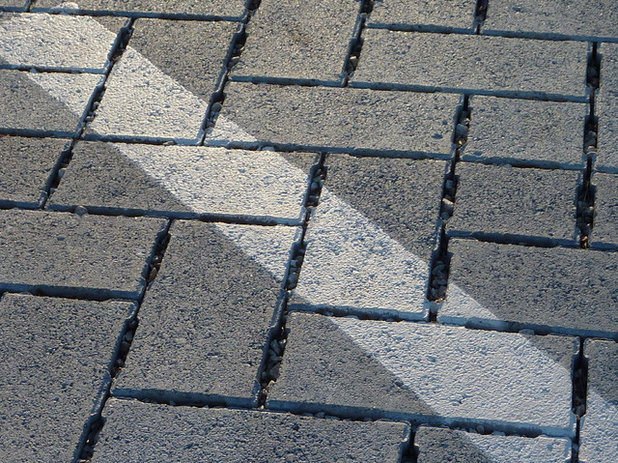
Billy Goodnick Garden Design
If your new driveway is on a billiards-table-flat part of your property, don't despair. Replace impermeable asphalt with attractive paving made of concrete masonry units with gravel-filled gaps in between. Water seeps through the spaces and into a thick substrata of angular, crushed rock. The voids between the rocks act as a temporary sponge. Slowly the water seeps into the soil below, helping to recharge the water table while sequestering pollutants and allowing soil organisms to neutralize them.





